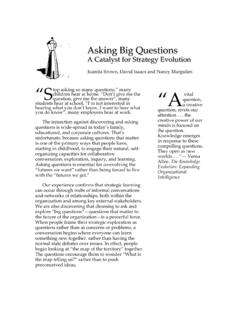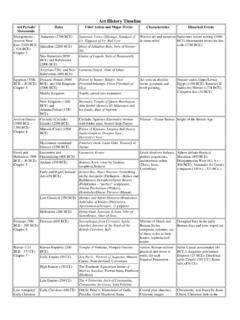Transcription of for Hosting World Café
1 2015 The World Caf Community FoundationCreative Commons Attribution Free to copy & distribute w/acknowledgement & link: Quick Reference Guidefor Hosting World Caf illustration by Nancy Margulies 2015 The World Caf Community FoundationCreative Commons Attribution Free to copy & distribute w/acknowledgement & link: are World Caf Conversations?is an easy-to-use method for creating a living network of collaborative dialogue around questions that matter in service to real work. Caf s in different contexts have been named in many ways to meet specific goals, for example Creative Caf s, Strategy Caf s, Leadership Caf s, and Community Caf s. World Caf conversations are based on the principles and format developed by the World Caf , a global movement to support conversations that matter in corporate, government, and community settings around the Caf a provocative metaphor enabling us to see new ways to make a difference in our lives and work.
2 The power of conversation is so invisible and natural that we usually overlook it. For example, consider all the learning and action choices that occur as people move from one conversation to another inside our organizations and communities. What if we considered all of these conversations as one big dynamic Caf , each a table in a larger network of living conversations which is the core process for sharing our collective knowledge and shaping our future? Once we become aware of the power of conversation as a key process in all aspects of our lives, we can use it more effectively for our mutual benefit. World Caf is alsoWe have outlined a series of guidelines for putting conversation to work through dialogue and engagement. If you use these guidelines in planning your meetings and gatherings, you ll find you are able to create a unique environment where surprising and useful outcomes are likely to occur.
3 A World Cafe is always intimate, even when it scales to very large numbers. What s essential about the World Caf method?The World Caf is built on the assumption that ..People already have within them the wisdom and creativity to confront even the most difficult challenges; that the answers we need are available to us; and thatwe are Wiser Together than we are by Nancy Margulies 2015 The World Caf Community FoundationCreative Commons Attribution Free to copy & distribute w/acknowledgement & link: Caf Guidelines:Conducting an exciting World Caf Conversation is not hard it s limited only by your imagination! The World Caf format is flexible and adapts to many different circumstances. When these design principles are used together they foster collaborative dialogue, active engagement, and constructive possibilities for ) Set the ContextPay attention to the reason you are bringing people together, and what you want to achieve.
4 Knowing the purpose and parameters of your meeting enables you to consider and choose the most important elements to realize your goals: who should be part of the conversation, what themes or questions will be most pertinent, what sorts of harvest will be more useful, Design Principles 2) Create Hospitable SpaceCaf hosts around the World emphasize the power and importance of creating a hospitable space one that feels safe and inviting. When people feel comfortable to be themselves, they do their most creative thinking, speaking, and listening. In particular, consider how your invitation and your physical set-up contribute to creating a welcoming ) Explore Questions that MatterKnowledge emerges in response to compelling questions. Find questions that are relevant to the real-life concerns of the group. Powerful questions that travel well help attract collective energy, insight, and action as they move throughout a system.
5 Depending on the timeframe available and your objectives, your Caf may explore a single question or use a progressively deeper line of inquiry through several conversational ) Encourage Everyone s ContributionAs leaders we are increasingly aware of the importance of participation, but most people don t only want to participate, they want to actively contribute to making a difference. It is important to encourage everyone in your meeting to contribute their ideas and perspectives, while also allowing anyone who wants to participate by simply listening to do so. 2015 The World Caf Community FoundationCreative Commons Attribution Free to copy & distribute w/acknowledgement & link: Caf Guidelines:5) Connect Diverse PerspectivesThe opportunity to move between tables, meet new people, actively contribute your thinking, and link the essence of your discoveries to ever-widening circles of thought is one of the distinguishing characteristics of the Caf.
6 As participants carry key ideas or themes to new tables, they exchange perspectives, greatly enriching the possibility for surprising new insights. Seven Design Principles, cont. 6) Listen Together for patterns & InsightsListening is a gift we give to one another. The quality of our listening is perhaps the most important factor determining the success of a Caf . Through practicing shared listening and paying attention to themes, patterns and insights, we begin to sense a connection to the larger whole. Encourage people to listen for what is not being spoken along with what is being shared. 7) Share Collective DiscoveriesConversations held at one table reflect a pattern of wholeness that connects with the conversations at the other tables. The last phase of the Caf , often called the harvest , involves making this pattern of wholeness visible to everyone in a large group conversation.
7 Invite a few minutes of silent reflection on the patterns , themes and deeper questions experienced in the small group conversations and call them out to share with the larger group. Make sure you have a way to capture the harvest - working with a graphic recorder is very a more in-depth look at the World Caf design principles, see the World Caf book, The World Caf : Shaping Our Futures through Conversations that Matter , or attend the Hosting World Caf : The Fundamentals Signature Learning Program at Fielding Graduate Cafe Design Principles Stamp Illustrations by Nancy Margulies 2015 The World Caf Community FoundationCreative Commons Attribution Free to copy & distribute w/acknowledgement & link: Caf Conversations Seat four (five max) people at small Caf -style tables or in conversation clusters. Set up progressive (at least three) rounds of conversation, approximately 20 minutes each.
8 Engage questions or issues that genuinely matter to your life, work, or community. Encourage participants to write, doodle and draw key ideas on their tablecloths (and/or note key ideas on large index cards or placemats in the center of the table). Upon completing the initial round of conversation, you may ask one person to remain at the table as a table host for the next round, while the others serve as travelers or ambassadors of meaning. The travelers carry key ideas, themes and questions into their new conversations, while the table host welcomes the new set of travelers. By providing opportunities for people to move in several rounds of conversation, ideas, questions, and themes begin to link and connect. At the end of the second or third round, all of the tables or conversation clusters in the room will be cross-pollinated with insights from prior conversations.
9 In the last round of conversation, people can return to their first table to synthesize their discoveries, or they may continue traveling to new tables. You may use the same question for one or more rounds of conversation, or you may pose different questions in each round to build on and help deepen the exploration. After at least three rounds of conversation, initiate a period of sharing discoveries & insights in a whole group conversation. It is in these town meeting-style conversations that patterns can be identified, collective knowledge grows, and possibilities for action you know what you want to achieve and the amount of time you have to work with, you can decide the appropriate number and length of conversation rounds, the most effective use of questions and the most interesting ways to connect and cross-pollinate a Glance 2015 The World Caf Community FoundationCreative Commons Attribution Free to copy & distribute w/acknowledgement & link: EtiquettePlay!
10 Experiment! Improvise!illustration by Avril Orloff 2015 The World Caf Community FoundationCreative Commons Attribution Free to copy & distribute w/acknowledgement & link: Importance of World Caf Question(s)The questions(s) you use for a World Caf conversation are critical to its success. Your Caf may explore a single question or several questions may be developed to support a logical progression of discovery throughout several rounds of in mind Well-crafted questions attract energy and focus our attention to what really counts. Experienced World Caf hosts recommend posing open-ended questions the kind that don t have yes or no answers Good questions need not imply immediate action steps or problem solving. They should invite inquiry and discovery vs. advocacy and advantage. You ll know you have a good question when it continues to surface new ideas and possibilities.










